Learning how to start an online business requires a firm understanding of the tools and strategies that lead to phenomenal success. You can start a profitable business even as a beginner and it’s not as difficult as you might think. There are just six simple steps to starting an online business.
1. Decide What Type of Online Business to Start
Your first step in launching an online business is determining what type of business you want to start. You need to consider what you want to sell and who the likely buyers for your products or services will be.
Determine What You Want to Sell
One of the toughest challenges all new online business owners face is deciding what they want to sell. Successful businesses offer in-demand products and services that solve customer needs, satisfy customer wants, and provide better value than competitors offer.
The perfect products or services to offer in your business will yield healthy profit margins—after all, you are starting an online business to make money. The products you promote also need to have sufficient demand; if demand is too low, you can’t make a profit with your online business.
Top strategies for choosing what to sell in your online business include:
- Creating products that solve a specific problem: When you discover a problem that many people have and come up with a terrific solution that addresses their struggles, you’re well on your way to business success.
- Choosing products that appeal to a special group: Online businesses that focus on highly focused groups can be extremely successful. You can build a thriving business by offering products that appeal to a specific hobby or other narrow interest area.
- Selling products you’re passionate about: One of the best ways to start an online business is with products you personally use and love. Your enthusiasm for those products will show.
- Starting a service business based on your expertise: Your professional experience or talent may lead to your next online business. Consider what you’re good at and how you can capitalize on those skills online. For example, if you’re an excellent writer, you could start an online writing and editing business. If you have 20 years of business leadership experience, you could start an online coaching business for leaders.

The Living Well Planner® is a product developed by and featured on Living Well Spending Less
You can create your own products, sell third-party products, or build a business around private label products. You can also sell digital downloads including informational products such as e-books, how-to guides, planners, printables, or software. Service-based businesses can also be quite profitable.
Define Your Target Audience
When first deciding how to start an online business, many new entrepreneurs make the mistake of trying to appeal to everyone. That seldom works, especially for small businesses.
Attempting to appeal to too many people inevitably leads to confusion; it’s simply not feasible to effectively serve everyone, especially when you’re a small business. Even Amazon started out just selling books. Your audience needs to be big enough to support your business, but not so big that you fail to make an impact in the marketplace.
Just as important, you also need to make sure that your target audience is not too narrow. If your customer prospect pool is too small, you’ll have a hard time making money.
The best way to assess whether you’re entering a viable marketplace is to do some customer research. Look to see if there are others who are in the same business you’re exploring. Assess what they are doing well and not so well, as their weak areas could be opportunities for you where you could shine.
Don’t stop with just competitive research. Do some first-hand research on your own too. Talk to people who use the types of products or services you’re thinking of selling and get their feedback on what they like and dislike about similar products. The more informed you are when you’re deciding what type of business to start, the greater the likelihood that your new online business will be successful.
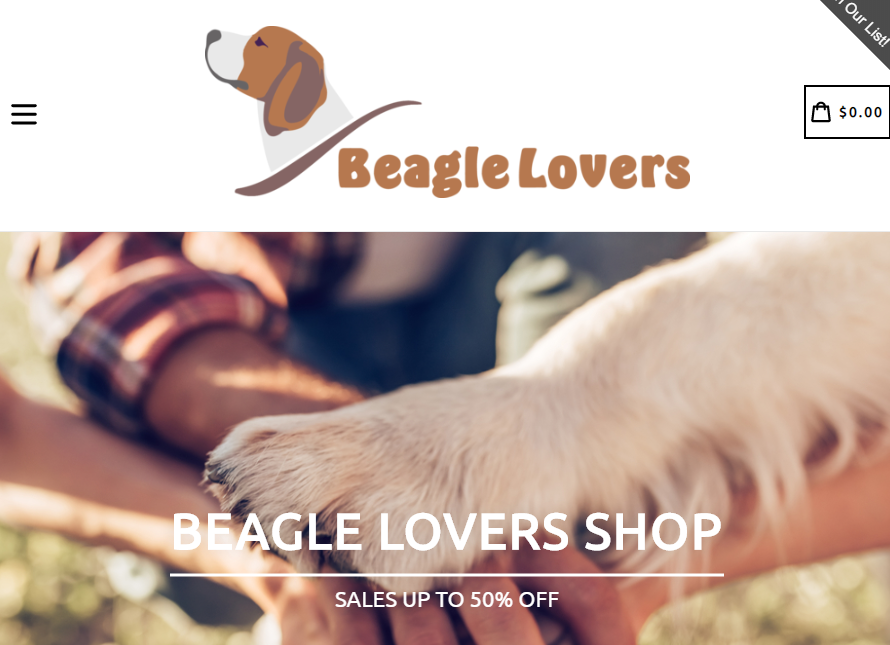
The Beagle Lovers Shop sells merchandise to beagle enthusiasts
2. Choose an Online Business Platform
One of the most confusing steps to starting an online business for most beginners is deciding how to actually build their online store. The good news is that you don’t have to possess extraordinary technical skills to launch a business. There are many powerful platforms on the market that allow you to launch an online business with little to no technical expertise.
Today’s online platforms cost a mere fraction of what you’d pay a web developer to create a website from scratch, which can easily cost well into the thousands. They also allow you to launch a new business more quickly than ever before.
If you’re not ready to build your own online store, you also have the option of starting your online business on others’ sites. Etsy and Amazon Marketplace are two examples of where you can host your business initiatives without creating your own website.
Popular Online Business Platforms
You have several options available to you when it comes to building your business online. Some of the most effective options are listed below.
Popular platforms for building your online business include:
- Shopify: This powerhouse selling platform offers tremendous flexibility. You can start selling products on your Facebook page and other social media channels through Shopify for only $9 a month. You can build a store on the Shopify platform or integrate Shopify with your website and start selling for only $29 a month. If you need help building and growing your business with Shopify, you can take one of the many courses on Shopify Academy for free.
- BigCommerce: This popular ecommerce option allows you to build your online store and scale it seamlessly as you grow. It also allows you to sell products across many social media channels. Plans start at $29.95 per month.
- WooCommerce plus WordPress: If you prefer to set up your online business via a WordPress site, you can use WooCommerce, a popular ecommerce plugin. There have been more than 72 million WooCommerce plugin downloads, making it an extremely popular avenue for building online stores. While the basic WooCommerce plugin is free, you can purchase WooCommerce extensions that help extend its functionality. WooSubscriptions, which starts at $199 a year, allows you to manage products with recurring payments. Another useful extension is WooCommerce Bookings, a tool that allows customers to book service appointments, starts at $249 per year.
- Etsy: Best known for handcrafted and custom products, Etsy is a popular platform for new businesses thanks to its built-in audience of more than 33 million buyers worldwide. You can set up your shop on Etsy for free in a matter of minutes and then tailor it to your tastes. Fees for selling products on Etsy include a 20 cent product listing fee, plus a 5% transaction fee, and a 3% plus 25 cent payment processing fee.
- Amazon Marketplace: You can launch your new business as a third-party Amazon marketplace seller. As a professional Amazon seller, you create your own product listings and product descriptions. You can source your own products, which means you take complete responsibility for fulfillment. If you prefer, you can join the Fulfillment by Amazon (FBA) program, where Amazon handles all fulfillment for you.
If you choose to join the FBA program, you’ll send your products to Amazon fulfillment centers that will store them and then ship your products when customers make a purchase. In addition, Amazon handles all customer service for you. When you choose to do your own product fulfillment, you’re also responsible for your own customer service.
Amazon charges $39.95 per month for a seller account. Product sales fees average 15% of the product sales price. FBA fees are based on the weight and size of your products. With FBA, you’ll pay from $2.41 per item shipped up to over $137 for items weighing 90 pounds or more.
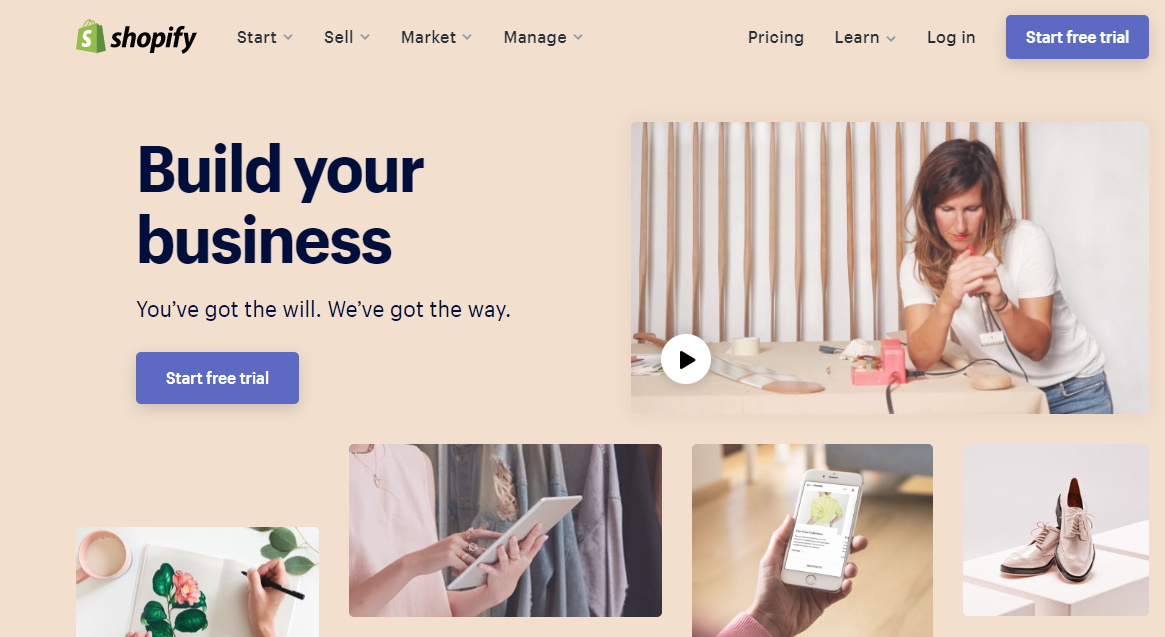
Shopify is a popular platform where you can build your online business
3. Develop Your Online Presence
Purchase a Domain
If you’re setting up your online business on a third-party site, such as Etsy or Amazon, you don’t need to purchase a domain. If you’re setting up your online business on your own website, you will need to purchase a domain.
You can purchase your domain through your hosting provider. Many offer a free domain in your first year of hosting service, though their domain fees after the first year typically skyrocket.
You may want to consider purchasing your domain from a provider that’s separate from your site host. This will protect you if you ever want to change hosting providers, as site hosts sometimes have long domain transfer times that can delay site moves. When you set up your domain via a provider that specializes in domain registration, such as Hover or NameCheap, you are protected from these types of delays.
Build Your Website or Online Store
Now that you have a domain and have decided on your platform, it’s time to build your online business. Basically you have two options, which are similar.
You can build a website that sells products or services while also featuring additional content, such as a blog or other information for your intended audience. Or, you can build an online store that focuses on selling products. An online store is simply a type of website, and many online stores also have additional content on them, though their main focus is always on selling products. Shopify is an excellent platform to use if your primary objective is building an online store.

Putchipuu is an online store built with Shopify
4. Attract Traffic to Your Online Business
Now that your online business is up and running, it’s time to attract people to your site who are likely to make a purchase. The more successful you are at getting your ideal customers to visit your site, the more likely you’ll make money selling your products or services.
Free Strategies for Attracting Website Traffic
The best free strategy for generating site traffic is Google search; however, getting people to find you on Google is not an easy task. You’ll need to make your site easy to find by mastering search engine optimization (SEO).
An SEO strategy involves a variety of tasks you can undertake to improve your visibility in search engines. It includes things like targeting keywords, getting other websites to link to your site, and more. Fast site load times are also important for SEO.
If you’ve built your website on a WordPress platform, you may want to install an SEO plugin on your site to help you with optimization. Yoast SEO is a popular plugin that offers both free and paid options.
Other free strategies for generating targeted website traffic include:
- Social media: YouTube, Facebook, Instagram, Pinterest, Twitter, and LinkedIn are popular social media channels that help you build awareness for your online business and generate traffic for your online store. The more share-worthy your social media content, the greater the impact it will have on driving quality traffic to your business.
- List your business on online directories: Make sure you research online directories that are related to the types of products and services you offer, and list your site wherever you find a good fit.
- Guest blog: Submitting guest blog posts to sites with followings that align with your ideal client is a good way to get exposure for your online business.
- Appear on podcasts: Reach out to podcast hosts who reach the same audience you’re targeting and offer to be a guest.
- Participate in online forums: If your ideal clients are hanging out on online forums, make sure you participate in those forums too.
- Email marketing: Building an email list of people interested in areas you serve is an excellent way to develop relationships that can turn into loyal customers. Mailchimp offers an email marketing plan that can help you start your email list for free, though they also have paid plans starting at $9.99 a month that offer additional functionality.
Paid Strategies for Attracting Website Traffic
The most common paid strategy for attracting targeted visitors to your online business is pay-per-click (PPC) advertising, and the most well-known advertising network is Google AdWords. Advertising costs on Google can be as low as a few cents per click, though most ads tend to be in the $1 to $2 per click range. However, if you’re advertising in a highly competitive area, you could pay $50 or more per click.
Nearly all social media channels also offer paid advertising programs. On most, you’ll find that you’ll pay in the $1 to $2 per click range, but you could pay significantly more if competition is intense for your target. The best way to explore paid ad opportunities and costs is to visit the channels that you believe your target customers use and explore each channel’s advertising programs, as terms vary significantly among the various providers.
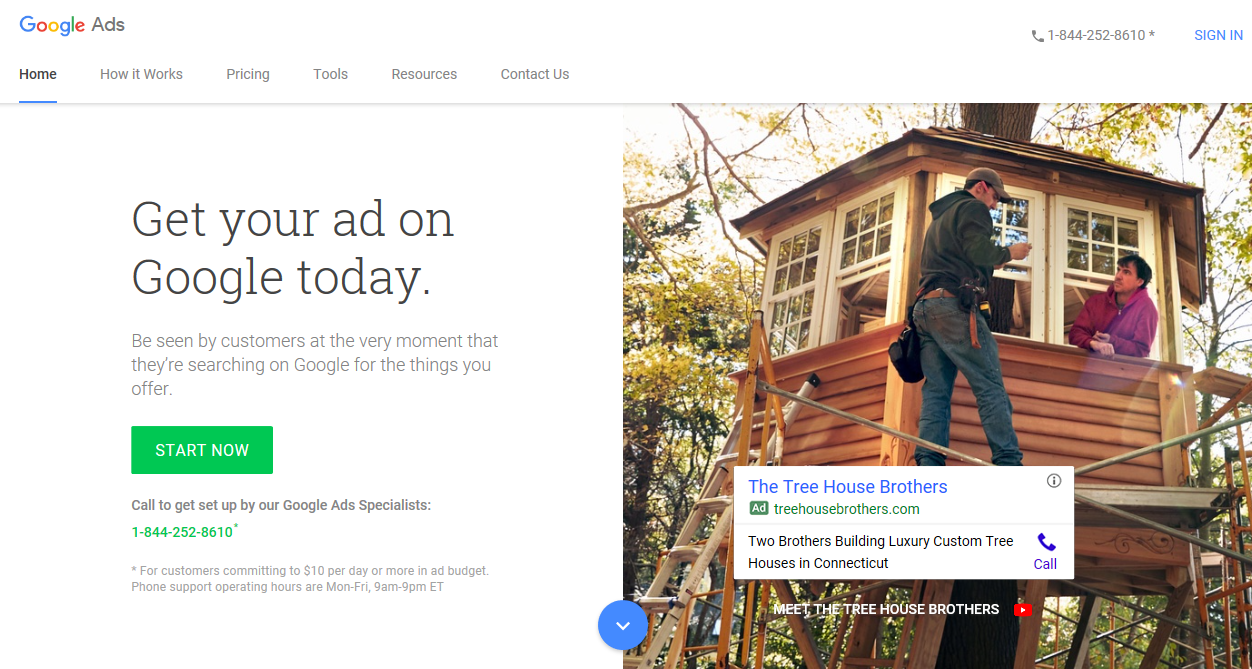
Google AdWords is a popular network where you can purchase ads to drive traffic to your online business
5. Convert Website Visitors Into Customers
Getting people to visit your online business is a great start, but where you’ll start making money is when you convert those visitors into paying customers. The better you get at encouraging the people who come to your website to buy from you, the faster your online business will grow.
The Importance of Strong Calls to Action (CTAs)
Many websites have great content and incredible products, but business owners forget to capture emails or ask for the actual sale. When people are on your site, you have the perfect opportunity to engage with them. Once they’ve left, they may never visit your site again. This is why you need to incorporate strong CTAs into your website.
There are many different ways you can use CTAs. At times your CTA will ask for the sale, perhaps using a button that says “Buy Now.” At other times you may want to use a CTA to ask site visitors to take a specific action, such as join your email list in return for something valuable that you’ll do for them. Always use CTAs to help direct your customer to the action you want them to take.
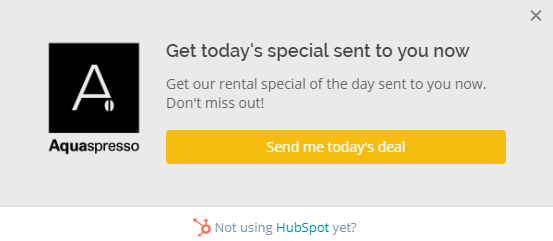
HubSpot user Aquaspresso uses a strong call to action on its site to build their email list
Popular Tips for Optimizing Sales
When potential customers visit your site, you want to do everything you can to assure them that they’ve come to the right place and that your business offers what they are looking for. You also want to overcome common sales objections—in other words, the top reasons why people hesitate to make a purchase.
You need to make your site visitors feel that they can trust you and that they are receiving an exceptional value with every purchase. Value doesn’t necessarily mean cheap or low price. Instead, value means that customers feel that the price they are paying is a fair exchange for the benefits that they’ll receive from whatever purchase they are making. The greater the perceived value, the more likely you’ll land the sale.
Here are some smart tactics you can employ to optimize sales:
- Use great images: Nothing sells as well as a vivid image that brings a product to life.
- Tout benefits, not just features: Don’t just explain the various features of your products—be sure to explain the benefits that those features bring to your customers. Tell them how the product makes their life easier or better.
- Add compelling videos: We live in the video age, and nothing lands sales better than a well-produced video that speaks to the heart of what your customers want and need.
- Include a prominent guarantee: If you don’t stand behind the products and services you sell, don’t expect customers to trust them or you. Sites with strong guarantees that are displayed prominently always outperform sites with weak or buried guarantees.
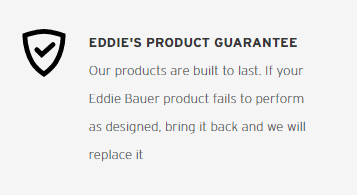
Eddie Bauer’s built-to-last product guarantee
- Use lots of testimonials: You can say your offerings are good, but it’s even better when others explain how good your products or services are. Be sure to feature satisfied buyers’ feedback on your site.
- Strong statistics sells: People take comfort in purchasing products that others have purchased or that have been deemed effective by an authoritative source. That’s why so many online sites include statistics on research findings, satisfied buyers, product reviews, and more on their sites.
- Provide great customer service: Potential customers will have questions, so you need to provide a variety of no-hassle ways for them to get their questions answered. Consider including a frequently asked questions (FAQs) section, online chat, email, and phone number on your website.
- Make it easy to buy from you: Make your check-out process seamless. Once your visitor has decided to buy something, make it exceptionally easy to complete that purchase.
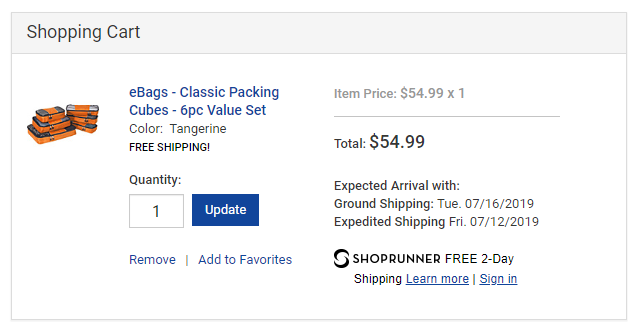
Easy-to-use shopping cart example from eBags
6. Measure Results & Refine Your Marketing Strategy
In all likelihood, you’re going to do some things perfectly from day one and other things simply won’t work and you’ll need to readjust. Take heart—this is common for new online business owners. In fact, it’s common for all online business owners.
If you want to be successful, you must keep a close eye on key performance indicators (KPIs) for your business You must also be willing to adjust your product, marketing, and advertising strategies when you see you’re not reaching your business goals.
Important metrics you should consider keeping a close eye on include:
- Return on investment (ROI): This is a measure of what you earn after all costs are considered.
ROI on Investment Formula
Total sales – total costs = net profit
Net profit / total costs * 100 = ROI
ROI Example:
Total sales = $10,000
Total costs = $4,500
Net Profit: $10,000 – $4,500 = $5,500
ROI: $5,500 / $4,500 * 100 = 122.22%
- Cost per acquisition (CPA): This is how much it costs you to acquire a lead or sale. For example, if you spent $1,000 and you sold 10 items, your CPA is $1,000 / 10 = $100.
- Sales conversion rate: This is a measure of how many people bought something from your site relative to the number of site visitors. For example, if 10,000 visitors came to your site and 150 bought something from you, your website conversion rate is 150 / 10,000, or 15%.
- Email opt-in rate: This is a measure of how many people opted-in to your email list relative to total site visitors. If you had 100,000 site visitors and acquired 1,500 email subscribers, your email opt-in rate is 1,500 / 100,000 = 15%.
- Shopping cart abandonment rate: This is a measure of how many people put items into your shopping cart and then leave a site without making a purchase. Shopping cart abandonment rates range anywhere from 50% to 80% for most online stores.
The best advice for how to start an online business is to realize that your work is never done. Once you launch, you must frequently evaluate how your site is performing, whether your product line-up is strong or needs enhancement, whether your costs are in-line or need refinement, and more. Keep a close watch on results and be willing to adjust your business, product, marketing, and promotion strategies until you achieve the financial results you want.
How to Start an Online Business: Frequently Asked Questions (FAQs)
How do you legally start an online business?
It’s best to consult directly with an attorney or business consultant before starting an online business. Laws vary by city, state, and country, and failing to adhere to the laws that apply to where you’re starting your online business can lead to costly penalties. You can also contact the Small Business Administration, as they have a number of resources available regarding the legal aspects of starting an online business.
What is the easiest online business to start?
The easiest small business to start for you depends on the skills you already possess and the amount of resources you have to invest. Affiliate marketing, where you promote other products and services, is one of the easiest businesses to start with little-to-no money.
What is the best online business I can do from home?
The best online business from home is one that you can do using your existing talents, skills, and resources. Starting a freelancing business is often an excellent choice for many business owners because there is a booming demand for people with all types of skill sets, including writing, design, programming, bookkeeping, video production, and more.
Bottom Line
For those who want to know how to start an online business, following these six steps is the best way to get your new online business up and running. Choosing in-demand items to sell, targeting your website to likely buyers, attracting site visitors, and creating compelling content are steps that lead to healthy business profits.
Another critical step for starting a successful business is choosing the right platform. If you’re serious about success, consider using Shopify for your business platform. You can start for as low as $9 per month. Be sure to check out Shopify’s free 14-day trial. Explore Shopify’s full features today.
Read More
0 تعليقات